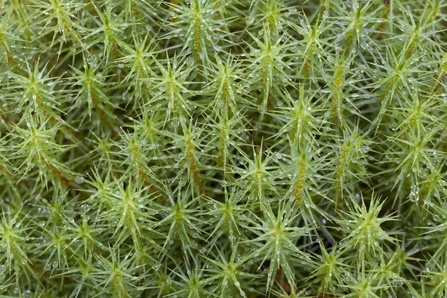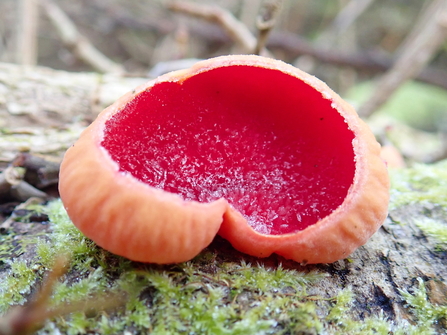Starling murmuration by Shutterstock (https://vimeo.com/303755572)
Video by Shutterstock
Danny Green/2020VISION
Starling murmuration by Shutterstock (https://vimeo.com/303755572)
Video by Shutterstock
During the winter months, large numbers of starlings visit Britain from the continent, seeking out the relative warmth of our island climate. As dusk arrives, the starlings set off for their communal roost in one of the most staggering natural spectacles of all.
Flocks arrive from all directions, gathering in the skies above their roost sites. As the numbers reach into the tens and hundreds of thousands, the ‘murmurations’ (the name for a flying flock of starlings) take on incredible shapes in the sky, contracting and expanding as one flock merges into another, and taking on a life of their own.
In our area, Thatcham Reedbeds can be a good place to spot starlings as they gather at dusk before roosting.

A close look at marsh hair moss. ©Peter Cairns/2020VISION
With only a few leaves clinging onto the branches, it’s easier to notice the tiny world of mosses and lichens. It’s well worth taking along a hand lens on a walk to get a closer look!
Species to look out for include silky forklet moss, marsh hair moss and sphagnum moss, which can be found on Wildmoor Heath.
If you're looking for something to add to your Christmas list, check out this wonderful book-length guide to finding mosses in our three counties.

The blonde stripe on a male wigeon is a tell-tale sign for identification.
Look for visiting winter wigeon on lakes, reservoirs and rivers, and listen out for their distinctive whistling call. The males have a pink breast and bold blonde stripe down their heads, while the females have a browner head and back. They eat vegetation and are often seen feeding on damp, marshy areas next to rivers and lakes.
Get started identifying different ducks and geese at College Lake, where you can ask reserve staff for help to tell them apart.

Little egret with a successful catch, by Jason Buck.
The long neck plumes of little egrets were once more valuable than gold and were smuggled into Europe during the 19th century. As a result, little egret populations plummeted until laws were put in place to protect them.
Once a very rare visitor from the Mediterranean, little egrets are now a common sight around our counties as they expand their range, possibly due to increasing temperatures caused by climate change. Britain and Ireland are now home to the most northerly breeding populations in the world.
Look out for them prowling the shallows at Letcombe Valley, or fishing on the island at Hosehill Lake.

Frosty mistletoe by Zsuzsanna Bird
Round clumps of mistletoe silhouetted against the sky are an iconic winter sight. If you can get close enough, check whether you’re actually looking at mistletoe or a witches' broom (you may remember from last month’s blog) which is actually a type of gall.
Mistletoe is highly poisonous, but you might see mistle thrushes, fieldfares and blackcaps eating the white berries, as they have evolved to cope with its toxic effect. The seeds are coated with a sticky substance called viscin which glues them to the branches, ready to germinate around April.

Holly by Ross Hoddinott
Another botanical beauty you may hear in songs at this time of year is, of course, holly - a rarity in the plant world because it stays green throughout the year, hence its association with Christmas. Look out for its spiked leaves in broadleaf woodlands across our area. Holly trees are either male or female, and if you see red berries, you know it’s a female tree.

A short-eared owl on the lookout. Danny Green/2020VISION
Unlike many species of owl, you may see short-eared owls hunting during the day as well as at dusk.
In the winter, our resident birds are joined by more from the continent. Look out for them hunting small mammals, and occasionally small birds, over wetlands and marshy grassland such as Chimney Meadows and the Upper Ray Meadows.
They have piercing yellow eyes and streaky feathers that camouflage them well against the grassland. Their 'ears' are actually tufts of feathers.

Scarlet elfcup at Dancersend by Mick Jones
In a frosted winter woodland, the luminous lobes of scarlet elfcup fungus almost seem to glow against the gloom.
This species can be seen in late winter and early spring on fallen twigs and branches (often hazel, elm and willow), usually buried under moss. Although not hugely common, we get fantastic specimens each year at our Dancersend and Pavis Woods reserve near Tring.

A plume moth stands out against its winter bathroom habitat. Suerob on Getty Images
You won’t have to travel far to find this December highlight. Plume moths look different to many other moths, with a distinct t-shape which resembles a narrow-winged aeroplane.
Masters of disguise, the beautiful plume moth is invisible among leaves and twigs, but is more conspicuous when it accompanies you in the bathroom, seeking warm shelter for the winter!
Pied wagtails are also very distinctive as they walk along the ground wagging their tails while searching for food.
While it may not match the spectacle of a starling murmuration, large flocks of pied wagtails will also gather to roost in winter to find safety in numbers. You can often see this in urban areas where they may roost in trees near offices and shops, so look up if you hear a crescendo of tweets overhead.